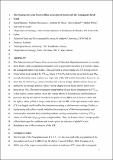Files in this item
The Palaeoproterozoic Francevillian succession of Gabon and the Lomagundi-Jatuli event
Item metadata
| dc.contributor.author | Bakakas, Karen | |
| dc.contributor.author | Moussavou, Mathieu | |
| dc.contributor.author | Prave, Anthony R. | |
| dc.contributor.author | Lepland, Aivo | |
| dc.contributor.author | Mbina, Michel | |
| dc.contributor.author | Kirsimäe, Kalle | |
| dc.date.accessioned | 2021-07-20T23:35:38Z | |
| dc.date.available | 2021-07-20T23:35:38Z | |
| dc.date.issued | 2020-07-21 | |
| dc.identifier.citation | Bakakas , K , Moussavou , M , Prave , A R , Lepland , A , Mbina , M & Kirsimäe , K 2020 , ' The Palaeoproterozoic Francevillian succession of Gabon and the Lomagundi-Jatuli event ' , Geology , vol. Early View . https://doi.org/10.1130/G47651.1 | en |
| dc.identifier.issn | 0091-7613 | |
| dc.identifier.other | PURE: 268762412 | |
| dc.identifier.other | PURE UUID: da6ca5d9-58b3-4fe8-bbcb-5f20e678c16b | |
| dc.identifier.other | ORCID: /0000-0002-4614-3774/work/78204836 | |
| dc.identifier.other | WOS: 000583944400014 | |
| dc.identifier.uri | https://hdl.handle.net/10023/23610 | |
| dc.description | The study was supported from Estonian Research Agency grant PRG447 to KK, AL and KB. | en |
| dc.description.abstract | The Paleoproterozoic Francevillian succession of Gabon has figured prominently in concepts about Earth’s early oxygenation and genesis of a large positive excursion in carbon-isotope values, the Lomagundi-Jatuli event (LJE). Here we present a detailed study of a 139-m-long core of Francevillian rocks marked by carbonate δ13C (δ13Ccarb) values of 5‰–9‰ that decline upsection to near 0‰, a trend inferred by many workers as a fingerprint of the LJE and its termination. However, we show that the shift in δ13Ccarb values coincides with a facies change: shallow-marine facies are marked by the strongly positive values, whereas deeper-marine facies (below storm wave base) are at ~0‰. The most circumspect interpretation of such facies dependence of δ13Ccarb is that shallow-marine settings record the isotope effects of local physical and biochemical processes driving the ambient dissolved inorganic carbon (DIC) pool to heavier values, and the lighter values (~0‰) in deeper-water facies track the DIC of the open-marine realm where δ13C was largely unaffected by fractionations occurring in shallow-water settings. Further, a transgressing redoxcline created conditions for precipitation of Mn-bearing minerals and chemotrophic microbial biota, including methane cycling communities evident by organic δ13C (δ13Corg) values of –4‰ and Δδcarb-org values as high as 46‰. Thus, the Francevillian C-isotope profile reflects basin-specific conditions and is not a priori an indicator of global C-cycle disturbances nor of the termination of the LJE. | |
| dc.format.extent | 6 | |
| dc.language.iso | eng | |
| dc.relation.ispartof | Geology | en |
| dc.rights | Copyright © 2020 Geological Society of America. This work has been made available online in accordance with publisher policies or with permission. Permission for further reuse of this content should be sought from the publisher or the rights holder. This is the author created accepted manuscript following peer review and may differ slightly from the final published version. The final published version of this work is available at https://doi.org/10.1130/G47651.1 | en |
| dc.subject | QE Geology | en |
| dc.subject | NDAS | en |
| dc.subject | SDG 14 - Life Below Water | en |
| dc.subject.lcc | QE | en |
| dc.title | The Palaeoproterozoic Francevillian succession of Gabon and the Lomagundi-Jatuli event | en |
| dc.type | Journal article | en |
| dc.description.version | Postprint | en |
| dc.contributor.institution | University of St Andrews. School of Earth & Environmental Sciences | en |
| dc.contributor.institution | University of St Andrews. Marine Alliance for Science & Technology Scotland | en |
| dc.contributor.institution | University of St Andrews. Scottish Oceans Institute | en |
| dc.contributor.institution | University of St Andrews. St Andrews Sustainability Institute | en |
| dc.contributor.institution | University of St Andrews. St Andrews Isotope Geochemistry | en |
| dc.identifier.doi | https://doi.org/10.1130/G47651.1 | |
| dc.description.status | Peer reviewed | en |
| dc.date.embargoedUntil | 2021-07-21 |
This item appears in the following Collection(s)
Items in the St Andrews Research Repository are protected by copyright, with all rights reserved, unless otherwise indicated.

